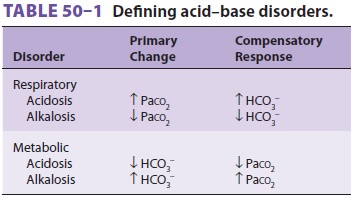Chapter: Clinical Anesthesiology: Perioperative & Critical Care Medicine: Acid-Base Management
Acid-Base Clinical Disorders
CLINICAL DISORDERS
A clear understanding of acid–base disorders
and compensatory physiological responses requires pre-cise terminology (Table
50–1). The suffix “-osis” is used here to denote
any pathological process that alters arterial pH. Thus, any disorder that tends
to reduce pH to a less than normal value is an acidosis,

whereas one tending to increase pH is termed an alkalosis. If the disorder primarily affects [HCO3−], itis termed metabolic. If the disorder primarily affects Paco2, it is
termed respiratory. Secondary
compensa-tory responses should be
referred to as just that and not as an “-osis.” One might therefore refer to a
metabolic acidosis with respiratory compensation.
When only one pathological process occurs by itself, the acid–base
disorder is considered to be sim-ple. The presence of two or more primary
processes indicates a mixed acid–base
disorder.
The suffix “-emia” is used to denote the net effect of all primary
processes and compensatory physi-ological responses on arterial blood pH. Because arterial blood
pH is normally 7.35–7.45 in adults, the term acidemia signifies a pH <7.35, whereas alkalemia signifies a pH >7.45.
Related Topics